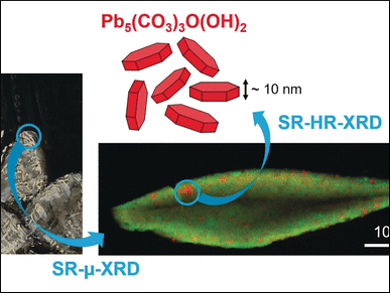Maestro’s Techniques
Rembrandt van Rijn’s paintings are renowned for their masterful representations of light and shadow and a characteristic plasticity generated by a technique called impasto (thick paint laid on the canvas that makes it stand from the surface). Victor Gonzalez, Delft University of Technology and Rijksmuseum, Amsterdam, both The Netherlands, and colleagues have analyzed impasto layers in some of Rembrandt’s paintings and found that the impasto unexpectedly contains a very rare lead mineral called plumbonacrite. This finding suggests that Rembrandt used a unique paint recipe.
“Before the study, one of the only [pieces of] information about impastos was that they were achieved using lead white pigment,” says Victor Gonzalez. “However, the precise recipe that Rembrandt used to achieve his impastos was not known,” he adds.
Lead white has been used in paintings since ancient times and, even today, its painterly properties still exceed those of its less toxic analogues. At the time Rembrandt created his artworks, lead white was produced by corrosion of metallic lead, resulting in the formation of a mixture of lead carbonates containing cerussite (lead carbonate, PbCO3) and hydrocerussite (Pb3(CO3)2(OH)2), which is a shiny white, mixable, and fast-drying powder.
Synchrotron X-Ray Diffraction Reveals Rare Mineral
For their analysis, the scientists sampled tiny amounts of impasto paint layers in Rembrandt’s Portrait of Marten Soolmans of 1634, Susanna, 1634, and Bathseba, 1654. Using a combination of synchrotron X-ray diffraction at the European Synchrotron Radiation Facility in Grenoble, France, they identified hydrocerussite and cerussite, but surprisingly, they also found another lead mineral, plumbonacrite. “Plumbonacrite is extremely rare in historic paint layers,” explained the researchers. “Its more notable occurrence was linked to degradation of the red lead (minimum) pigment in a Van Gogh painting,” they added.
In addition, the researchers detected plumbonacrite solely in the impasto layer, never in the layers below, and the other component of lead white, cerussite, was nearly absent. Why was the impasto chemical composition different from that of the underlayer although apparently the same pigments were used?
Plumbonacrite
The scientists tried to find answers by following the chemistry of lead compounds. Plumbonacrite is only stable in alkaline (basic) environments. Under the acid production conditions of lead white, the mineral rapidly transforms into (hydro)cerussite. In contrast, a stable, highly basic lead mineral is litharge (PbO). Arguing that PbO was sometimes used as a binding additive at the time, the team proposed that Rembrandt could have added PbO in the binder for his impasto. This would explain the composition of the white pigments. In a medium made alkaline by the litharge binder, lead carbonates would transform to plumbonacrite.
As a next step, the researchers plan to investigate other Rembrandt paintings to check if the artist consistently used the same recipe. From the point of view of art history, it would also be important to see if other painters used the same technique.
- Identification of Unusual Plumbonacrite in Rembrandt’s Impasto by Using Multimodal Synchrotron X-ray Diffraction Spectroscopy,
Victor Gonzalez, Marine Cotte, Gilles Wallez, Annelies van Loon, Wout de Nolf, Myriam Eveno, Katrien Keune, Petria Noble, Joris Dik,
Angew. Chem. Int. Ed. 2019.
https://doi.org/10.1002/anie.201813105




